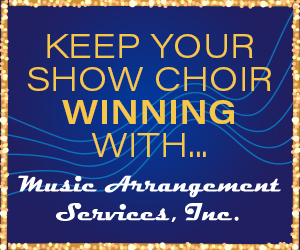
Some people see only glitz and glitter, not the serious musicianship underpinning the showmanship.
Successfully lobbying for operating funding or larger pieces of equipment used by show choirs-such as platforms, risers or acoustical shell-depends on three critical factors. In academic terms, they could be considered the “Straight A’s”-for attention, acoustics and assurance.
Attention-Being Seen
Maintaining an active performance schedule in the community garners attention and nurtures long-term support. “We perform for local service clubs as much as we can-Rotary, Kiwanis, Lionesses,” notes Cydney Dixon, District Director of Music, who also teaches choir and band at Lower Lake High School (LLHS) in Lower Lake, Calif. LLHS’ show choir, the Blue Notes, includes an accompanying jazz band.
“Next year, we’ll create some smaller groups so we can meet more clubs’ needs during busy times like Christmas,” she adds.
Dixon never mentions money the first time her group performs. “When these organizations and businesses meet the kids and see what we have to offer, the money will come later,” explains Dixon.
Because wineries are prominent in the area, Dixon balances her group’s need for support with caution about exposing students to events where alcohol is served. For example, the Blue Notes provide clean-up services the day after an annual winery arts fundraiser.
“We’re performing community service and we’ve earned a reputation for working hard,” she says. Dixon also rewards student participation by tracking volunteer activity individually; a portion of each donation is credited to that student’s account for tour expenses. She also recommends a charitable website, www.donorschoose.org, where schools and other organizations promote their specific needs.
Acoustics-Sounding Good
While a high participation rate among students and strong attendance at performances are desirable goals, success is more than a numbers game. Choir programs never shortchange acoustical considerations because music is learned and experienced by listening.
The group’s ability to hear itself is crucial to music-making.Risers and an acoustical shell both help shape the acoustical space around a choir, affecting the group’s ability to hear itself. When they can’t hear themselves, a choir compromises its intonation, balance, timing and confidence. Without these elements, a choir cannot create a beautiful sound.
In any performance environment, the lack of reflective surfaces-such as acoustical shells or overhead panels-will make it difficult for musicians to hear each other. In addition to losing the sense of ensemble, the undirected sound energy may be dissipated or absorbed before fully reaching the audience. For these reasons, it is critical to have reflective surfaces behind and above the choir.
Proper acoustics help the students’ education onstage and also educate the audience about what a true sound can be. That’s the essence of what a performance is about.
When a choir travels away from its “home” performance environment, a portable acoustical shell can provide important benefits from the sense of familiarity and acoustical security it offers. Choirs typically give their best performances in familiar locations.
Along with an acoustical shell and adequate sound reflection, a tiered arrangement of vocalists on risers or staging platforms is also essential for optimal sound projection. If performers are all on one level, even when dancing around, a portion of the group’s sound output will always be directed at the back of their fellow performers.
Risers or platforms also offer greater flexibility for performances; their arrangement can correspond with the performance to create acoustics appropriate for different songs. “Risers are very important to the presentation of both show choirs and concert choirs,” notes Joel Biggs, President and Executive Producer of FAME Events. FAME produces the Show Choir National Championship Series, which includes six regional competitions.
According to Biggs, platforms enable a large show choir to be seen and heard by an appreciative audience and judging panel. Multiple elevations allow a choir director to position his/ her singers in exactly the right configuration to get the optimal blend of voices.
“Show choir is to concert choir like marching band is to concert band,” Biggs declares. “Once we had to sacrifice good acoustics for movement. Now show choirs can have both-they can have highly energetic choreography and still be in the proper position to be heard. Choreography and vocals would be much more limited without platform systems.”
New show choir programs join the FAME series each year and most have not yet used platforms. Almost always, Biggs sees these groups return the following year with a show designed for platforms. “This happens because they witness firsthand the clear difference-in sound quality, aesthetics and ease of scoring by judges,” he concludes.
Assurance-Feeling Secure
For musicians to feel poised and focused when performing, they must have confidence that their choral equipment’s beauty is more than skin-deep. Safety should not be compromised in any way. This is particularly true of platforms or risers; even the slightest instability can cause anxiety.
On a practical side, risers or platforms must be quiet and well-constructed, engineered to handle a significant amount of weight. A mixed high school choir with 70 voices might easily weigh more than four tons! Risers or platforms that squeak or creak will detract from the quality of a performance. When choreography and movement are involved, instability can be dangerous.
Choral risers and platforms should be easy for a small number of people to move, set up and take down. Touring models should be relatively lightweight and easy to transport. A back railing is a particularly important safety feature for younger musicians.
An unfortunate number of performing sites use old, beat-up risers or platforms that are difficult to work with. If not unsafe, they certainly look insecure. Audience members would never tolerate trying to find their seats while the auditorium floor was moving and pitching beneath them, but this is a daily occurrence for performers on old risers and platforms.
Some school administrators may have unrealistic expectations about the longevity of such equipment, believing that its metal construction lasts forever, or at least 25 years. But how many of these same administrators would be satisfied driving a 25-yearold car?
Just as automotive technology has dramatically improved over the past quarter century, choral equipment has also advanced. Today’s risers, platforms and acoustical shells are made from stronger materials, with enhanced designs and more durable construction methods. More than ever, this choral equipment represents an investment that pays dividends through meaningful instruction and memorable performances.
While the stature of arts education was enhanced by “No Child Left Behind,” no law can guarantee that an individual school’s choir program will not be left behind when funding dollars are allocated.
By focusing on Straight A’s-attention, acoustics and assurance-choir directors can better obtain the equipment necessary to ensure the success of their programs for years to come.











